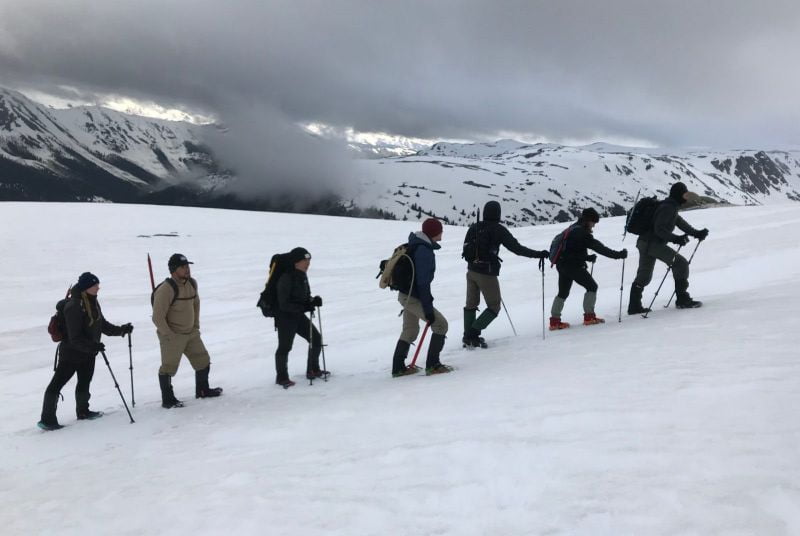
BLACKSBURG – Wading through waist-deep snow on a Rocky Mountain peak in Colorado, Cat Wilson wasn’t sure that she and her group would reach the 13,500-foot summit in the Mount Massive Wilderness.
“We were post-holing through snow that was up to our hips, and I thought that we’d have to turn around,” recalled Wilson, a rising senior majoring in meteorology and a member of the Virginia Tech Corps of Cadets. “Then we got out of it and reached the ridgeline, and the views were gorgeous.”
The climb was the culmination of a three-credit field course in the Department of Geography, in which the meteorology program is based. Under the guidance of Instructor David Carroll, seven students traveled to Colorado this summer to learn about weather systems and meteorology while negotiating the challenges of high altitudes and rapidly changing weather conditions.
“This was a physical geography, weather, and climate field course, where students would be exposed to high mountain areas and different ecological life zones,” said Carroll, who also leads the annual Hokie Storm Chase to the Great Plains. “The goal was to study the glacial landscape that was formed in these places and some of the weather conditions in these climates. It was a little difficult this year because road access to trail heads in the backcountry was limited due to deep late-season snow pack and continually stormy conditions.”
Another challenge was acclimatizing to the higher altitudes. To prepare the students for the elevation gains and minimize the risks of acute mountain sickness, Carroll utilized a technique to help them gradually adjust to the lower oxygen levels.
“The strategy was to climb high and sleep low,” Carroll explained. “The first night we camped out at 6,600 feet. The next day we climbed to 10,000 feet and then came back down and slept at 8,600 feet for two nights before venturing higher and camping out above 10,000 feet. We yo-yoed up and down the mountains to try to get everyone adjusted to the altitude. It was all about ensuring the safety of the group, which is something I really try to focus on.”
Mountains play an important role in meteorological forecasting, which is a central reason why Carroll and Associate Professor Lynn Resler have worked to offer mountain field courses for students in the College of Natural Resources and Environment, including a 2014 field course that brought a group to the Cascade Mountains in Washington state. Closer to home, Carroll has led student efforts to install weather stations on the highest peaks in Virginia and West Virginia for data collection and forecasting efforts.
“When we talk about climate, mountains are essentially islands in the sky,” Carroll noted. “For forecasting weather and understanding the dynamics of the atmosphere, we like to look at the atmosphere in three dimensions. Standing on the surface of the earth only gives us a limited amount of data, but being able to monitor the atmosphere higher up allows us to access all dimensions of what is taking place.”
Wilson echoed the value of seeing weather in three dimensions: “At the highest points, we were at the cloud level, so we could see everything happening in the atmosphere. Some days we could see storms forming. There was one point when we were at Wolf’s Creek Pass on the Continental Divide Trail and we could see the entire formation of a hailstorm.”
For Peyton Truslow, a meteorology student and a cadet entering his last semester at Virginia Tech, the course provided valuable practical skills.
“A big part of the experience was learning to work in the weather and understanding what mountain weather is like. It was a meteorologically focused class, but we also learned how to use an ice axe in a self-arrest and how to wear crampons and climb steeper slopes. As we climbed, we’d have instructions on how to navigate the environment.”
A typical day saw the students rise early and make their way to a trailhead. They would hike in the midday until they reached a peak or vista, or a grove of bristlecone pine trees, one of the longest-living life forms on earth. Along the way the students practiced mountaineering skills while studying the meteorological patterns and geographic terrain of Colorado. The group timed their return each day to ensure that they were below the tree line before lightning developed over the high terrain.
“Every day was an adventure, a new experience,” said Kat Carney, a meteorology major who is also a cadet. “The weather was definitely a challenge: if you were above the tree line and there was lightning, you were likely to get hit. And these weren’t mild thunderstorms — these were strong, boom-clap storms, with the thunder immediately following the lightning since we were essentially in the clouds.”
The goal of the course is to give students exposure to challenging terrain and get real-time practice witnessing weather conditions and navigating them successfully.
“If you’re a meteorology student who is interested in the weather, this course is an eye-opening experience,” Carroll said. “To actually go out to Colorado and experience this geography firsthand is invaluable: it goes a long way towards rounding out a student’s experience as a meteorology or geography major. It helps students fit what they’ve been studying in class into a real-world context, and I think they also learn quite a bit about themselves through the process.”
Truslow, who will be joining the Air Force as a combat systems officer in January 2020, echoes Carroll’s sentiment, emphasizing the value of such hands-on experiences.
“You can sit in a classroom and talk about thunderstorms and lightning and rain, but it’s another thing to be caught out there in a storm as the temperature drops. It’s a humbling experience, and it definitely gives you an appreciation for what you’re attempting to work with, what you’re attempting to help people understand.”
Krista Timney
Virginia Tech


